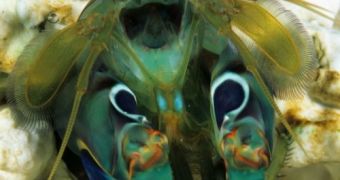Our eyes cannot make the distinction between regular light and polarized light. However, with the help of a pair of polarized sunglasses, one would be able to see how the world would look like if only we were able to see polarized light, for example. The sky would suddenly become darker, giving you a better perspective of the objects surrounding you, and the water would no longer reflect light from its surface enabling one to clearly see the depths.
Light becomes polarized when its electric field is aligned to a specific direction. A light beam having all its photons polarized vertically would basically have the electric field oscillating on an up and down direction, while horizontally polarized light has the electric field oscillating from side to side. It's no secret that some insects, crustaceans, spiders and other anthropods are able to see light at certain degrees of polarization, but until now biophysicists thought that such creatures only see linearly polarized light, or light with electric fields pointing in a specific direction.
Light can also be polarized circularly. This happens when the electric field is being rotated either in a clockwise or anticlockwise direction. Animals on Earth should not be able to observe light polarized in such a way, mostly because such natural light sources are scarce.
Nevertheless, Max Plank Institute for Biophysics researcher Sonja Kleinlogel and Andrew White from the University of Queensland have recently shown that mantis shrimp have evolved in such a way that their eyes are able to see both linear and circularly polarized light. Furthermore, Kleinlogel revealed that live mantis shrimp behave differently when exposed to different circular light polarization.
Mantis shrimp have spherical compound eyes, composed of several hundred smaller eyes, separated into two hemispheres by a mid-band. Experiments have shown that each of these three individual structures react differently when subjected to light of different linear and circular polarization. The two hemispheres are responsible for processing linear polarized light, while the mid-band is only sensitive to circularly polarized light.
If this is true and the shrimp eyes can indeed see all types of light polarization, then it would mean that they are sensitive to all six parameters that describe light polarization, otherwise known as the Stokes parameters.
According to White, the mid-band of the shrimp eye is composed of biological cells able to act as a 'quarter wave plate', converting circularly polarized light into linearly polarized light. Then the light is picked up by cells able to see linearly polarized light. By doing so, the mantis shrimp eye is able to process slight changes in the light polarization patterns.
"Some of the animals that the [mantis shrimp] like to eat are transparent, and quite hard to see in sea-water - except they're packed full of polarizing sugars - which makes them light up like Christmas trees as far as these shrimp are concerned", explained Kleinlogel.
Queensland scientists, however, found that the light reflected from mantis shrimp is circularly polarized, suggesting that it may have some role in mating.
The team has now planned to design and build an artificial mantis shrimp eye. "This would give us a great opportunity to figure out what these little critters really perceive in their environment", said Kleinlogel.

 14 DAY TRIAL //
14 DAY TRIAL //